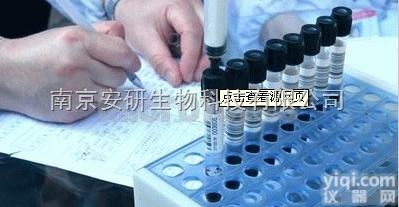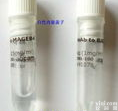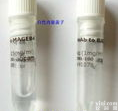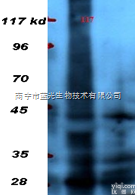| 产品介绍 | background:
Integrins are heterodimeric proteins made up of alpha and beta subunits. At least 18 alpha and 8 beta subunits have been described in mammals. Integrin family members are membrane receptors involved in cell adhesion and recognition in a variety of processes including embryogenesis, hemostasis, tissue repair, immune response and metastatic diffusion of tumor cells. This gene encodes a beta subunit. Multiple alternatively spliced transcript variants which encode different protein isoforms have been found for this gene. [provided by RefSeq, Jul 2008]
Function:
Integrins alpha-1/beta-1, alpha-2/beta-1, alpha-10/beta-1 and alpha-11/beta-1 are receptors for collagen. Integrins alpha-1/beta-1 and alpha-2/beta-2 recognize the proline-hydroxylated sequence G-F-P-G-E-R in collagen. Integrins alpha-2/beta-1, alpha-3/beta-1, alpha-4/beta-1, alpha-5/beta-1, alpha-8/beta-1, alpha-10/beta-1, alpha-11/beta-1 and alpha-V/beta-1 are receptors for fibronectin. Alpha-4/beta-1 recognizes one or more domains within the alternatively spliced CS-1 and CS-5 regions of fibronectin. Integrin alpha-5/beta-1 is a receptor for fibrinogen. Integrin alpha-1/beta-1, alpha-2/beta-1, alpha-6/beta-1 and alpha-7/beta-1 are receptors for lamimin. Integrin alpha-4/beta-1 is a receptor for VCAM1. It recognizes the sequence Q-I-D-S in VCAM1. Integrin alpha-9/beta-1 is a receptor for VCAM1, cytotactin and osteopontin. It recognizes the sequence A-E-I-D-G-I-E-L in cytotactin. Integrin alpha-3/beta-1 is a receptor for epiligrin, thrombospondin and CSPG4. Alpha-3/beta-1 may mediate with LGALS3 the stimulation by CSPG4 of endothelial cells migration. Integrin alpha-V/beta-1 is a receptor for vitronectin. Beta-1 integrins recognize the sequence R-G-D in a wide array of ligands. Isoform beta-1B interferes with isoform beta-1A resulting in a dominant negative effect on cell adhesion and migration (in vitro). In case of HIV-1 infection, the interaction with extracellular viral Tat protein seems to enhance angiogenesis in Kaposi's sarcoma lesions. When associated with alpha-7/beta-1 integrin, regulates cell adhesion and laminin matrix deposition. Involved in promoting endothelial cell motility and angiogenesis. Involved in osteoblast compaction through the fibronectin fibrillogenesis cell-mediated matrix assembly process and the formation of mineralized bone nodules. May be involved in up-regulation of the activity of kinases such as PKC via binding to KRT1. Together with KRT1 and GNB2L1/RACK1, serves as a platform for SRC activation or inactivation. Plays a mechanistic adhesive role during telophase, required for the successful completion of cytokinesis.
Subcellular Location:
Cell membrane. Recycling endosome. Melanosome. Cleavage furrow. Cell projection > lamellipodium. Cell projection > ruffle. Isoform beta-1B does not localize to focal adhesions. Highly enriched in stage I melanosomes. Located on plasma membrane of neuroblastoma NMB7 cells. In a lung cancer cell line, in prometaphase and metaphase, localizes diffusely at the membrane and in a few intracellular vesicles. In early telophase, detected mainly on the matrix-facing side of the cells. By mid-telophase, concentrated to the ingressing cleavage furrow, mainly to the basal side of the furrow. In late telophase, concentrated to the extending protrusions formed at the opposite ends of the spreading daughter cells, in vesicles at the base of the lamellipodia formed by the separating daughter cells. Colocalizes with ITGB1BP1 and metastatic suppressor protein NME2 at the edge or peripheral ruffles and lamellipodia during the early stages of cell spreading on fibronectin or collagen. Translocates from peripheral focal adhesions sites to fibrillar adhesions in a ITGB1BP1-dependent manner.
Tissue Specificity:
Isoform beta-1A is widely expressed, other isoforms are generally coexpressed with a more restricted distribution. Isoform beta-1B is expressed in skin, liver, skeletal muscle, cardiac muscle, placenta, umbilical vein endothelial cells, neuroblastoma cells, lymphoma cells, hepatoma cells and astrocytoma cells. Isoform beta-1C and isoform beta-1C-2 are expressed in muscle, kidney, liver, placenta, cervical epithelium, umbilical vein endothelial cells, fibroblast cells, embryonal kidney cells, platelets and several blood cell lines. Isoform beta-C-2, rather than isoform beta-1C, is selectively expressed in peripheral T-cells. Isoform beta-1C is expressed in non-proliferating and differentiated prostate gland epithelial cells and in platelets, on the surface of erythroleukemia cells and in various hematopoietic cell lines. Isoform beta-1D is expressed specifically in striated muscle (skeletal and cardiac muscle).
Post-translational modifications:
The cysteine residues are involved in intrachain disulfide bonds.
Similarity:
Belongs to the integrin beta chain family.
Contains 1 VWFA domain.
SWISS:
P05556
Gene ID:
3688
Database links: Entrez Gene: 3688 Human Omim: 135630 Human SwissProt: P05556 Human Unigene: 643813 Human
Important Note:
This product as supplied is intended for research use only, not for use in human, therapeutic or diagnostic applications.
|
 phospho-Integrin beta 1(Tyr783)磷酸化整合素β1/Integrin β1抗体
phospho-Integrin beta 1(Tyr783)磷酸化整合素β1/Integrin β1抗体
 磷酸化酪氨酸抗体 磷酸化酪氨酸抗体
磷酸化酪氨酸抗体 磷酸化酪氨酸抗体
 Phospho-HER3 (Tyr1289)碱性磷酸酶AP标记抗体,碱性磷酸酶AP标记磷酸化HER3受体抗体
Phospho-HER3 (Tyr1289)碱性磷酸酶AP标记抗体,碱性磷酸酶AP标记磷酸化HER3受体抗体
 Phospho-HER2 (Tyr686)碱性磷酸酶AP标记抗体,碱性磷酸酶AP标记磷酸化HER2受体抗体
Phospho-HER2 (Tyr686)碱性磷酸酶AP标记抗体,碱性磷酸酶AP标记磷酸化HER2受体抗体
 磷酸化Wee1抗体 磷酸化WEE1蛋白抗体
磷酸化Wee1抗体 磷酸化WEE1蛋白抗体
 phospho-AKT1/PKB1/2/3(pThr473)peptide 磷酸化蛋白激酶B抗原(丝氨酸磷酸化位点:473)抗体厂家供应
phospho-AKT1/PKB1/2/3(pThr473)peptide 磷酸化蛋白激酶B抗原(丝氨酸磷酸化位点:473)抗体厂家供应
 磷酸化蛋白激酶B抗原(丝氨酸磷酸化位点:473)抗体厂家
磷酸化蛋白激酶B抗原(丝氨酸磷酸化位点:473)抗体厂家
 I03/9820/9902 磷酸化丝氨酸抗体生物素标记/苏氨酸抗体生物素标记/酪氨酸抗体生物素标记
I03/9820/9902 磷酸化丝氨酸抗体生物素标记/苏氨酸抗体生物素标记/酪氨酸抗体生物素标记
 磷酸化HER3受体 / 磷酸化HER3受体抗体
磷酸化HER3受体 / 磷酸化HER3受体抗体
 磷酸化HER2受体 / 磷酸化HER2受体抗体
磷酸化HER2受体 / 磷酸化HER2受体抗体
 磷酸化HER3受体 / 磷酸化HER3受体抗体
磷酸化HER3受体 / 磷酸化HER3受体抗体
 磷酸化HER2受体 / 磷酸化HER2受体抗体
磷酸化HER2受体 / 磷酸化HER2受体抗体